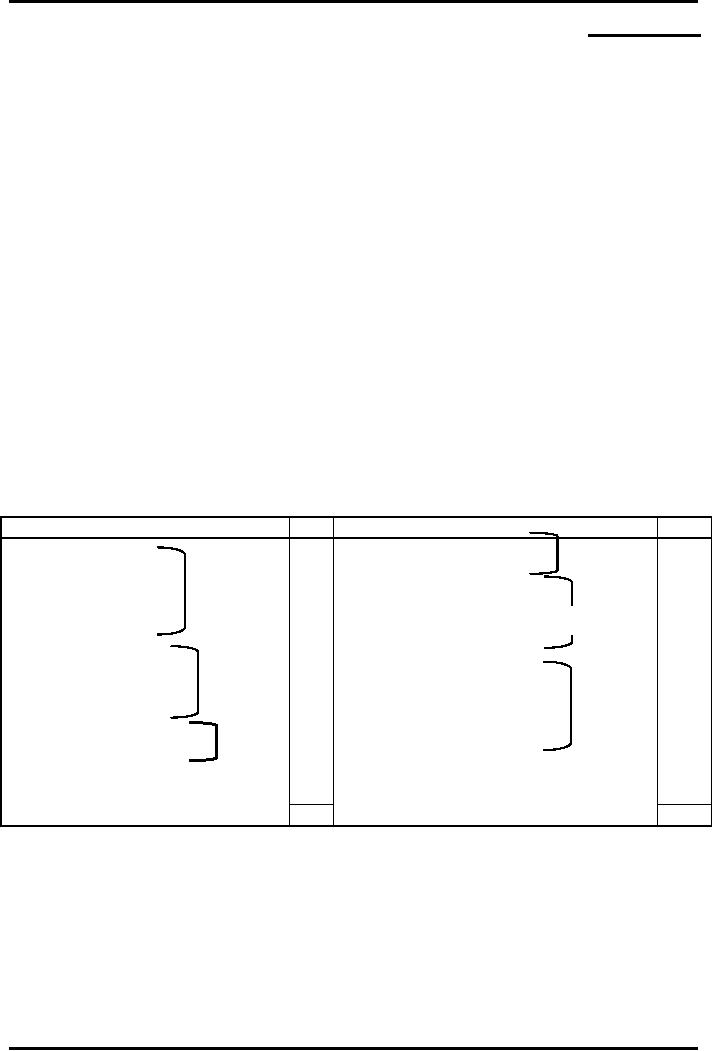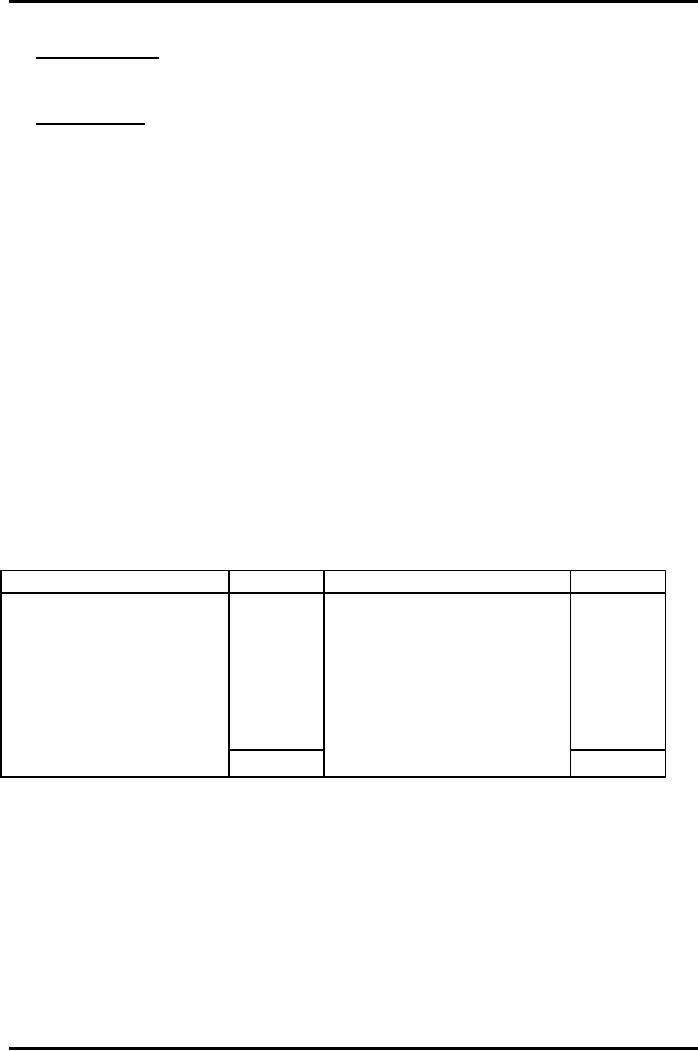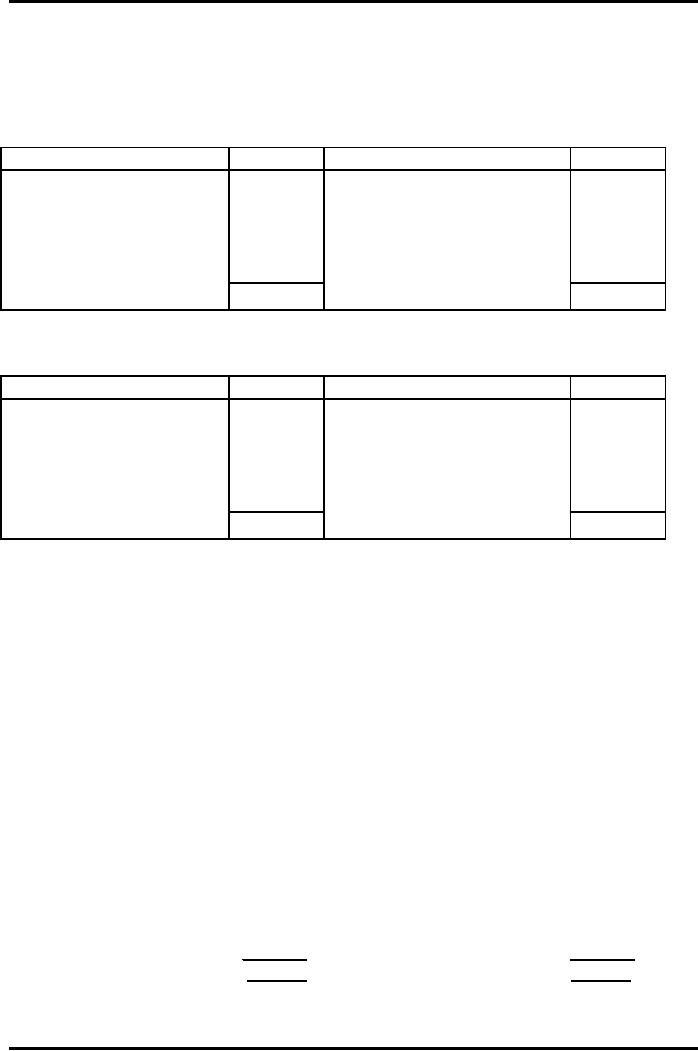 |
BRANCH ACCOUNTING SYSTEMS |
| << DEPARTMENTAL ACCOUNTS 2 |
| BRANCH ACCOUNTING >> |

Advance
Financial Accounting
(FIN-611)
VU
LESSON
# 11
BRANCH
ACCOUNTING SYSTEMS
Accounting
system for Retail Dependent
Branch
There
are three methods to
calculate profits of a retail
dependent branch. Any of
these
can
be used to calculate branch
profits; nevertheless, selection of
method will depend
upon
the nature of operations,
size and level of complexity of
the transaction.
� Debtor
system
� Income
statement system
� Stock
and debtor system
Debtor
System
This
system of accounting is suitable for
the small sized branches. In
this system a
Branch
a/c is opened for each of the
branches in the main ledger of
head office. Each
and
every transaction that is
made in between the head
office and its branches
is
entered
into the specific branch
account. For example there
are two branches of a
business
one in Gujranwala and the
second in Karachi. The head
office will open two
ledger
accounts in its main ledger
one named and titled as
Gujranwala Branch a/c and
the
other as Karachi Branch a/c.
The branch accounts are
maintained in such a way
that
these will give the amount of
profits or losses of the
respective branches.
Lets
have a glance, how does a
Branch a/c look like?
Books
of the Head
Office
Branch
Account
Particulars
Rs.
Particulars
Rs.
Op.
Stock
***
Op. Creditors
***
Opening
Op.
Debtors
***
Op. Outstanding
Expenses
***
Liability
Opening
Op.
Petty Cash
***
Cash received from
branch
Assets
Op.
Furniture
Cash
Sales
***
***
Drawings
Op.
Prepaid Expenses
Collection
from Debtors
***
***
Goods
sent to Branch
***
Goods Returned by
Branch
***
Fresh
Cash
sent to branch
Cl.
Stock
***
Capital
for
branch expenses
***
Cl. Debtors
***
Closing
Assets
for
any other purpose
***
Cl. Petty Cash
***
Cl.
Creditors
***
Cl. Furniture
***
Closing
Liability
Cl.
Outstanding Expenses
***
Cl. Prepaid Expenses
***
Profit
& Loss A/c (Profit)
***
Profit
and Loss A/c
(Loss)
***
***
***
In
the above Branch a/c we can
very well observe few facts which are as
under:
1. At
the beginning of the year
the Branch a/c is debited with
the opening
balances
of assets lying with the branch and
credited with the opening
balances
of
the branch liabilities.
Doing this debit and credit
as a result we have
opening
capital
balance at debit side of the
Branch a/c
2. At
the ending of the year
the Branch a/c is credit with
the closing balances
of
assets lying
with the branch and debited with
the closing balances of the
branch
liabilities.
Doing this debit and credit
as a result we have closing
capital balance
at
credit side of the Branch
a/c
51

Advance
Financial Accounting
(FIN-611)
VU
3. During
the year the head
office has sent to branch
goods for selling and cash
for
whatever
purposes. These both are
debited to the Branch a/c.
This can be
considered
as fresh capital (resources)
introduced by head office into
its branch.
4. During
the year the head
office has received goods
(as returned goods)
and
cash
(resources) from its branch,
the source might be any one
e.g. cash sales or
credit
customer or even by selling
branch assets. This receipts
of cash and
return of
goods is credited to the
Branch a/c. This can be
considered as
drawings
made by the head office out
of the branch.
Now
applying the rules studied
in the single entry accounting
system we can get
the
amount of net profit/loss of the
branch.
Accounting
Entries in the Books of Head
Office
1.
For opening balances of assets at
the branch
Branch
a/c
Branch
assets a/c (individual accounts)
2.
For opening balances of
liabilities at the
branch
Branch
liabilities a/c (individual
accounts)
Branch
a/c
3.
For goods sent to the
branch
Branch
a/c
Goods
sent to branch a/c
4.
For return of goods by the
branch
Goods
sent to branch a/c
Branch
a/c
5.
For remittance of cash or
cheque to the branch
Branch
a/c
Cash/Bank
a/c
6.
For cash or cheque received
from the branch
Cash/Bank
a/c
Branch
a/c
7.
For closing balances of assets at
the branch
Branch
asset a/c (individual
accounts)
Branch
a/c
8.
For closing balances of
liabilities at the
branch
Branch
a/c
Branch
liabilities a/c (individual
accounts)
9.
For closing goods sent to
branch account.
Goods
sent to branch a/c
Purchases
a/c
52

Advance
Financial Accounting
(FIN-611)
VU
10.
For closing branch account
into the profit and loss
account
Incase
of profit
Branch
a/c
Profit
& loss a/c
Incase
of loss
Profit
& loss a/c
Branch
a/c
Solved
Problem
Problem
# 1
From
the following information relating to
the Sialkot
Branch for
the year ending 31st
March,
2007, prepare the Branch
Account in the books of head
office.
Rs.
Rs.
Opening
Stock at Branch
37,500
Cheque sent to
Branch
Opening
Debtors in Branch
75,000
Salaries
22,500
Opening
Petty Cash at Branch
750
Rent
& Taxes
3,750
Goods
Sent to Branch
630,000
Petty
Cash
2,750
Cash
Sales
150,000
Closing Stock at
Branch
62,500
Cash
Received from Debtors 525,000
Closing
Debtors at Branch
120,000
Goods
Returned by Branch
5,000
Closing
Petty Cash at Branch
500
Credit
Sales
570,000
Solution:
Books
of Head Office
Sialkot
Branch Account
Particulars
Rs.
Particulars
Rs.
Opening
Stock
37,500
Cash
Received from Branch
675,000
Opening
Debtors
75,000
Goods
returned from Branch
5,000
Opening
Petty Cash
750
Closing
Stock
62,500
29,000
120,000
Cash
sent to Branch
Closing
Debtors
Goods
sent to Branch A/c
630,000
Closing
Petty Cash
500
General
Profit & Loss A/c
90,750
(Profit)
863,000
863,000
Problem
# 2
Excellent
Garments of Multan has a branch at
Lahore. Goods are supplied
to the branch
at
cost. The expenses of the
branch are paid from Multan and
the branch keeps a
sales
journal
and the debtors' ledger only.
From the following information
supplied by the
branch,
prepare a Branch Account in
the books of the head
office. (All figures in
rupees)
Opening
Stock
24,000
Closing
Debtors
9,150
Closing
Stock
18,000
Opening
Debtors
?
Goods
received from HO
33,600
Bad
Debt
140
Credit
Sales
41,000
Exp.
paid by Head office
10,400
Cash
Sales
17,500
Cash
received from Debtors
37,900
53

Advance
Financial Accounting
(FIN-611)
VU
Pilferage
of goods by the
employees
(Normal
Loss)
2,000
Solution:
In
the books of Head Office
(Multan)
Lahore
Branch Account
Particulars
Rs.
Particulars
Rs.
Opening
Stock
24,000
Cash Received from
Branch
17,500
6,200
Cash Received from
Debtors
Opening
Debtors
37,900
10,400
Closing Stock
Cash
sent to Branch
18,000
33,600
Closing Debtors
Goods
sent to Branch a/c
9,160
General
Profit & Loss a/c
8360
(Profit)
82,560
82,560
Working:
Debtors
Account
Particulars
Rs.
Particulars
Rs.
Op.
Debtors (Balancing
6,200
Cash Received from
Debtors
37,900
41,000
Bad Debts
fig)
140
Sales
(credit)
Cl.
Debtors c/f
9,160
47,200
47,200
Problem
# 3
From
the following particulars of a dependent
branch. Prepare Branch a/c
showing
the
profit or loss of the branch
for the year ended
31-12-2007: (all figures are
in Rs.)
Opening
stock
30,000
Goods
sent to branch
90,000
Cash
sent by head office
Cash
sales
120,000
for
salaries
10,000
for
other expenses
4,000
Closing
stock could not be ascertained but it is
know that the branch usually
sells
at
cost plus 20% of the
cost.
Solution:
Branch
Account
Rupees
Rupees
Opening
stock
30,000
Cash received from branch
120,000
Goods
sent to branch
90,000
closing
stock
20,000
Cash
sent to branch
14,000
Profit
& loss a/c
6,000
140,000
140,000
54

Advance
Financial Accounting
(FIN-611)
VU
Working:
Calculation
for Closing
Stock
Sales
at
120%
120,000
Cost
of sales at
100%
120,000
x100/120 = 100,000
Opening
stock + Goods sent
Closing stock = Cost of
sales
30,000
+ 90,000 X = 100,000
X
(closing stock) = 120,000
100,000
X
(closing stock) =
20,000
55
Table of Contents:
- ACCOUNTING FOR INCOMPLETE RECORDS
- PRACTICING ACCOUNTING FOR INCOMPLETE RECORDS
- CONVERSION OF SINGLE ENTRY IN DOUBLE ENTRY ACCOUNTING SYSTEM
- SINGLE ENTRY CALCULATION OF MISSING INFORMATION
- SINGLE ENTRY CALCULATION OF MARKUP AND MARGIN
- ACCOUNTING SYSTEM IN NON-PROFIT ORGANIZATIONS
- NON-PROFIT ORGANIZATIONS
- PREPARATION OF FINANCIAL STATEMENTS OF NON-PROFIT ORGANIZATIONS FROM INCOMPLETE RECORDS
- DEPARTMENTAL ACCOUNTS 1
- DEPARTMENTAL ACCOUNTS 2
- BRANCH ACCOUNTING SYSTEMS
- BRANCH ACCOUNTING
- BRANCH ACCOUNTING - STOCK AND DEBTOR SYSTEM
- STOCK AND DEBTORS SYSTEM
- INDEPENDENT BRANCH
- BRANCH ACCOUNTING 1
- BRANCH ACCOUNTING 2
- ESSENTIALS OF PARTNERSHIP
- Partnership Accounts Changes in partnership firm
- COMPANY ACCOUNTS 1
- COMPANY ACCOUNTS 2
- Problems Solving
- COMPANY ACCOUNTS
- RETURNS ON FINANCIAL SOURCES
- IASB’S FRAMEWORK
- ELEMENTS OF FINANCIAL STATEMENTS
- EVENTS AFTER THE BALANCE SHEET DATE
- PROVISIONS, CONTINGENT LIABILITIES AND CONTINGENT ASSETS
- ACCOUNTING POLICIES, CHANGES IN ACCOUNTING ESTIMATES AND ERRORS 1
- ACCOUNTING POLICIES, CHANGES IN ACCOUNTING ESTIMATES AND ERRORS 2
- BORROWING COST
- EXCESS OF THE CARRYING AMOUNT OF THE QUALIFYING ASSET OVER RECOVERABLE AMOUNT
- EARNINGS PER SHARE
- Earnings per Share
- DILUTED EARNINGS PER SHARE
- GROUP ACCOUNTS
- Pre-acquisition Reserves
- GROUP ACCOUNTS: Minority Interest
- GROUP ACCOUNTS: Inter Company Trading (P to S)
- GROUP ACCOUNTS: Fair Value Adjustments
- GROUP ACCOUNTS: Pre-acquistion Profits, Dividends
- GROUP ACCOUNTS: Profit & Loss
- GROUP ACCOUNTS: Minority Interest, Inter Co.
- GROUP ACCOUNTS: Inter Co. Trading (when there is unrealized profit)
- Comprehensive Workings in Group Accounts Consolidated Balance Sheet